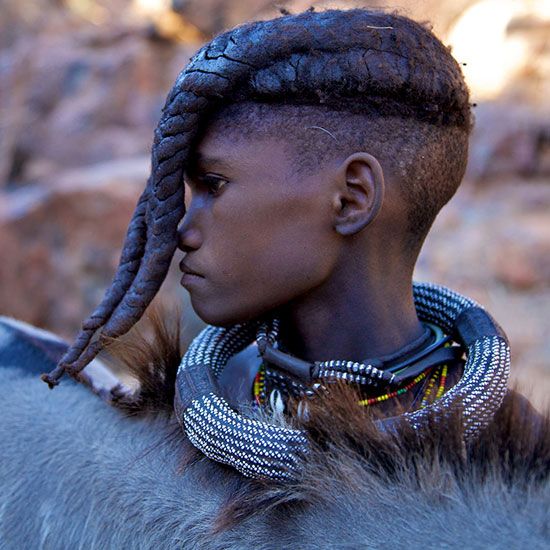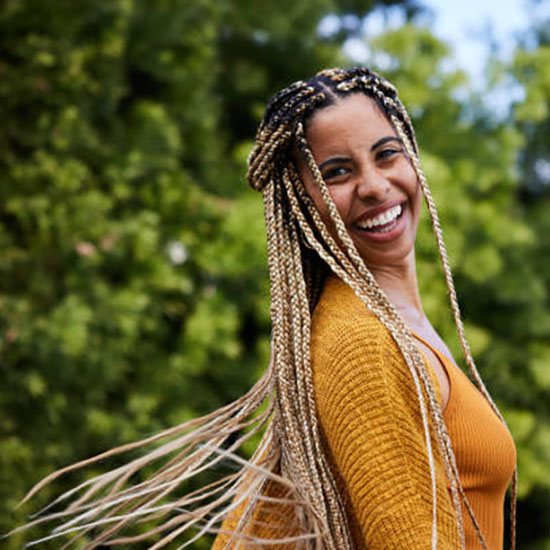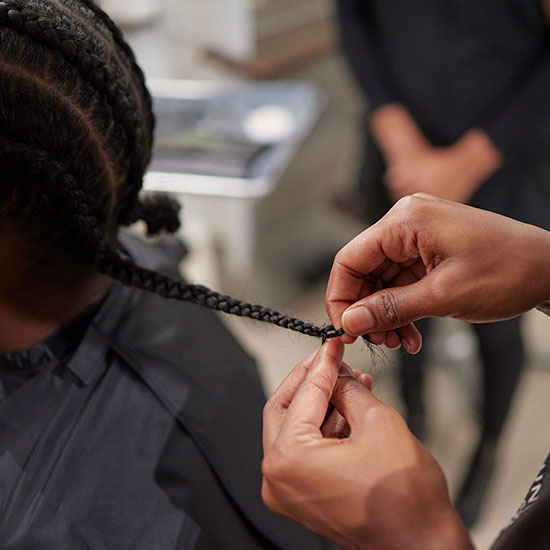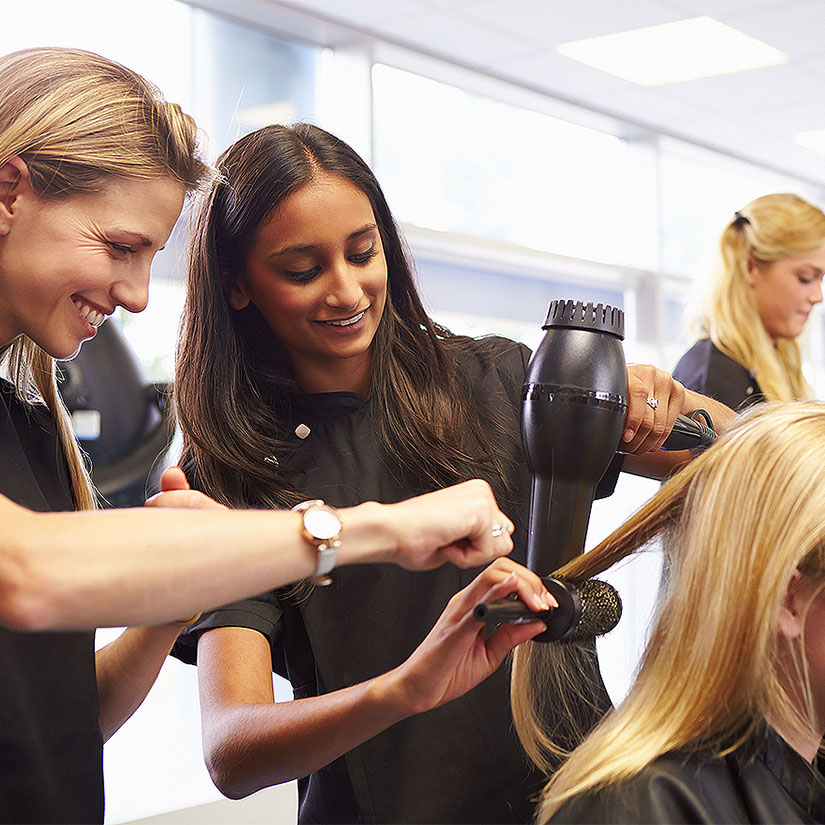The braided hairstyles you see on red carpets, in fashion shows and all over social media are more than just trends. Braids have a rich history and deep cultural significance. Originating in Africa, hair braiding has evolved over the centuries to become a practical protective style, a marker of identity and social status, and a powerful form of self-expression. Braiding is also one of the most highly sought-after skills in the beauty industry, blending cultural traditions with modern trends.
If you’re an aspiring cosmetologist, learning the art of braiding can set you apart in a competitive industry. It’s a valuable skill that allows you to serve a broader customer base – and it’s an incredible opportunity to build a thriving career in beauty.
At Tricoci University of Beauty Culture, we’re passionate about empowering the next generation of hairstylists with the skills, techniques and knowledge they need to thrive in the beauty industry. Whether your dream is to work in a salon or to run your own successful business, mastering hair braiding can open all the right doors.
Watch Tricoci’s hair braiding segment on CBS Chicago
The Deep-Rooted History of African Hair Braiding
The tradition of hair braiding dates back to at least 3500 BC. Way more than a hairstyle, braiding is more like a story passed down through generations. Some of the earliest artistic depictions of braids – specifically cornrows – were found in rock paintings from the Sahara desert.
Braiding as Identity and Culture
In ancient African societies, hairstyles could signify a person’s marital status, age, religion, wealth, rank and other aspects of identity. For example, cornrows, one of the oldest and most recognizable styles, were often used to indicate family lineage and status. And for centuries, the Yoruba people of Nigeria have created elaborate designs to honor ceremonial and spiritual occasions.
The Himba people of Namibia are known for their detailed, intricate braiding. Many of the styles and their meanings remain unchanged, even today. For these semi-nomadic people, dreadlocks worn in front of a girl’s face signified she was going through puberty, while locks tied at the back meant she was seeking a marriage partner.
Beyond their cultural signifiers, Himba braiding styles are also extremely practical. The Himba live in one of the harshest environments on earth, where the sun is intense and water is often scarce. Clay-coated braids are a brilliant protective style in this region of the world.

Box braids originated in South Africa at least 5,000 years ago. Women signaled their readiness for marriage, their economic status and other markers of status through jewels, cowrie shells and colorful beads worn in their box braids. Since box braids can take up to ten hours to create, women who could afford the time and expense of this style were perceived to be wealthy and successful.
Braiding’s Journey to the U.S. and Beyond
The transatlantic slave trade disrupted many African cultural traditions, but hair braiding survived as an act of resistance and resilience. It became a way for enslaved people to maintain and signify their heritage.
Since the process of creating elaborate hairstyles involves washing, combing, oiling, twisting and decorating the hair, braiding often took hours or even days. So these practices enabled the sharing and passing down of cultural traditions, strengthening community and family bonds.
In the 1960s and 70s, the Black Power movement brought back natural hairstyles like cornrows and afros as symbols of pride and defiance. Fast forward to today, and African hair braiding has become a symbol of beauty, resilience and cultural pride embraced around the world.
The Evolution of Hair Braiding in the Beauty Industry
While braiding has deep roots in the past, braided styles are still buzzworthy today. The truth is that braids have never really gone out of style.
The Rise of Braiding in Pop Culture
Over the past decade, braids have exploded in popularity, with styles like knotless braids, Fulani braids and box braids becoming mainstream beauty trends spotted on everyone from Beyonce to First Lady Michelle Obama.
Few celebrities have embraced traditional African braiding styles like Alicia Keys has, making them a key part of her image and identity. As the singer told Glamour UK in 2020, “Hair is such a gorgeous expression of our individuality and deserves to be respected.” She adds, “I’ve always been proud of wearing braids and I love learning about the power of hair. I’ve always felt royal when I wear braids. There’s something so beautiful about the Blackness of it, about my African ancestry that I just feel truly connected to.”
Social media has been an important gamechanger in the mainstreaming of braids. Platforms like Instagram, TikTok and YouTube inspire people around the world to experiment with new hairstyles, exchange styling tips and share personal experiences. It’s also created a platform where stylists can grow thriving businesses or even become successful influencers.
Braiding as Part of the Natural Hair Movement
Another driver of the rise in popularity of braids is their practical, protective benefits. Braiding helps shield hair from weather conditions, helps hair retain moisture, reduces exposure to the damage of heat styling and even promotes hair growth.
With the rise of the natural hair movement, today more people are moving away from chemical relaxers and embracing protective styles like braids. Knotless braids, faux locs, and bohemian twists have become hugely popular, allowing people to protect their natural hair while experimenting with different looks.
As a cosmetologist, this presents a major business opportunity. The demand for skilled braiders is higher than ever, and being able to offer expert braiding services can set you apart in a competitive industry.
The Skill & Technique Behind Braiding
The growing popularity of braids opens up new opportunities for beauty professionals. Braiding requires both creativity and precision – a combination today’s clients want to pay for. Box braids, cornrows, Fulani braids, knotless braids, faux locs and Senegalese twists all have unique cultural roots, and they also require unique methods.
Core Braiding Techniques Every Stylist Should Know

Great stylists are made from learning great fundamentals. Here are some key braiding techniques every cosmetology student should be familiar with.
Cornrows are a variation on the traditional three-strand braid. Hair is braided flat against the scalp, with a raised row across the head. Cornrows are often
created in straight lines but they can also be elaborate geometric designs.
Box braids are a wildly popular modern style. Box braids get their name from sectioning the hair into squares (boxes) and braiding down its length, across the entire scalp. Box braids usually incorporate hair extensions and there is a range of different box braid styles. Goddess box braids, micro box braids, jumbo box braids and other variations each require slightly different styling techniques.
Knotless braids are different from other braiding styles because they don’t start with a tight knot at the scalp. They’re considered gentler on the hair and scalp and many clients like them because they’re less likely to cause damage from tension.
Named for the Fulani people of West Africa, Fulani braids are typically a mix of thin to medium cornrows on the front and sides, with single braids at the back of the head. This style is all about clean, defined lines and often includes the addition of beads, shells and other decorative elements.
Senegalese twists, also known as “rope twists,” are created from two strands twisted together to resemble a three-strand twist. Incorporating Kanekelon hair, Senegalese twists are similar to box braids, but with a looser feel.
Faux locs are a popular protective style that uses synthetic hair to create the look of locs, applied using either a crochet or braid-in method.
Hair Health and Scalp Care in Braiding
One of the most important aspects of creating braided styles is knowing how to protect the hair and scalp. Braiding too tightly can actually cause traction alopecia, a form of hair loss caused by excessive pulling on the hair. So professional stylists need to be able to assess hair texture and scalp sensitivity, learn techniques to prevent tension-related damage and properly apply moisturizing and strengthening products. Skilled braiders are essentially hair health experts!
Any modern braided style takes a minimum of two hours, and can take upwards of 10! But with proper care, these styles last from six weeks to three months. That kind of investment means clients are looking for trained professionals who understand the complexity of these styles.
Braiding requires precision, creativity and practice and mastering these techniques can truly set a stylist apart in the beauty industry. Tricoci University of Beauty Culture offers training in a variety of braiding techniques so our students have the opportunity to offer this in-demand service to a wide range of clients.
The Business of Braiding: A High-Demand Skill in Cosmetology
The global Black haircare industry is worth billions, and braiding is one of its fastest growing sectors.
Career Opportunities for Braiders
Many skilled braiders earn six figures annually – especially the ones who can build a strong clientele. Professionally-trained braiders can work in high-end salons that cater to clients looking for premium braided styles, open their own salons or set their own hours as freelance braiders or “locations.” There’s also growing demand for braiders who work behind the scenes in music videos, editorial shoots and fashion weeks.
Licensing and Regulation
Licensing requirements for professional braiders vary from state to state. Some states have specific licenses for braiders, while others require a full cosmetology license. At Tricoci University, we help aspiring braiders understand legal requirements and professional standards so they’re prepared to pursue their goals and build a compliant, successful career.
The financial potential, flexibility and independence – as well as the practically “recession-proof” demand for beauty services like braids – is a winning combination for anyone passionate about braiding.
Learning Hair Braiding at Tricoci University
The art of hair braiding requires precision, creativity and practice. But it also requires proper education and a thorough understanding of the fundamentals. While some stylists learn through trial and error, formal training from an accredited cosmetology program offers students the opportunity to develop the technical expertise and business smarts to set themselves up for long-term success.

At Tricoci University of Beauty Culture, braiding is integrated into our comprehensive cosmetology curriculum. Students get hands-on experience in both traditional and modern techniques. From box braids and cornrows, to twists and locs, our program is designed to give students exposure to a wide range of hairstyling methods across different cultures and hair types. We believe that truly skilled stylists aren’t limited by race, ethnicity, or hair texture. They’re equipped to create stunning results for any hair type that comes to their chair.
Many Tricoci University graduates have gone on to work in top salons, start their own thriving businesses and even become industry leaders.
How to Get Started: Next Steps for Aspiring Cosmetologists
Given the growing appreciation for natural and culturally significant hairstyles, now is the perfect time to start your cosmetology career with a focus on braiding. Mastering the art of African hair braiding is an opportunity to both transform your career and empower your clients. Whether you’re passionate about creating intricate designs, protecting natural hair or building a thriving beauty business, braiding can open the door to a rewarding career.
At Tricoci University of Beauty Culture, we believe that great hair stylists are lifelong learners. Our comprehensive cosmetology program equips students with technical expertise, business knowledge and hands-on experience in a wide range of hairstyling techniques, including braiding, twists, locs, and protective styles. With the right training, dedication and passion, it’s possible to become a versatile, in-demand stylist ready to work with all hair types and textures.
If you’re ready to take your hairstyling career to the next level, take the next step and explore Tricoci’s programs, meet our instructors and start your journey to becoming a skilled, confident professional in the beauty industry.





